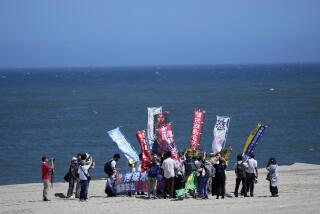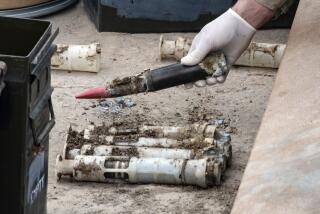Environment : Stalin’s Nuclear Testing May Now Threaten Leningrad : The Soviet dictator’s scientists scuttled a German minelayer filled with nuclear waste in nearby Lake Ladoga. Officials are concerned about possible radioactive contamination to the city’s water supply.
- Share via
LENINGRAD, Soviet Union — Three hours by boat from shore, in a top-secret zone of Lake Ladoga, rests a half-sunken ship that Soviet authorities say could one day pose a terrifying threat to this city and even to the Baltic Sea beyond.
The vessel, a German minelayer from World War II, is filled with radioactive wastes from experiments ordered in the 1950s by the ruthless head of dictator Josef Stalin’s secret police, Lavrenti V. Beria.
Although there is no evidence of contamination so far, the fear is that as the ship’s hull rusts, there may be radioactive leaks into the lake, which supplies Leningrad’s water system and also feeds into the Baltic. At 124 miles long and covering 6,835 square miles, Ladoga is Europe’s largest body of fresh water.
“We cannot leave for our children and grandchildren these dark stains that our parents were forced to create,” says Anatoly P. Sklyanin, chief of Leningrad’s nuclear safety department.
It turns out that the military has a plan to lift the ship in the spring and dispose of its radioactive wastes elsewhere to avert the threat. But that revelation, which only came after a Leningrad reporter first published the story about the formerly secret ship last month, has raised other fears among environmentalists.
Specialists agree the ship poses too great a threat to be left where it is. But at the same time, they are concerned that without extraordinary precautions, moving the ship from its resting place of more than 30 years could hasten its disintegration and start the spread of the radioactive materials. Sklyanin says even pieces of the ship’s metalwork and flecks of paint are now “hot,” as is the water that was pumped into its sealed compartments to flood and sink the vessel in the first place.
After the Leningrad newspaper’s report, civilian authorities demanded a role in the military’s plan to lift the ship, arguing that the safety of the city and the Baltic environment were at stake.
Also, the specialists hope to pressure a still-reluctant military to reveal more information about the early Soviet nuclear program and the legacy it may have left behind.
There could be hundreds more such secret nuclear waste caches around the country, says Alexander N. Penyagin, chairman of the subcommittee on nuclear ecology of the Supreme Soviet, or national legislature.
“I will not be surprised if we find more such barges, or spots where nuclear waste had been buried long ago and has poisoned underground waterways,” Penyagin says.
“It’s part of that gigantic, inhumane regime of secrecy under Beria, which has huge consequences for us,” he says. “Some of it can be explained by the excuse that they did not know what we know now about disposal of radioactive wastes. But in my opinion the main cause was that Beria, who headed the nuclear program, regarded people in a completely inhuman way.”
“This gives us a chance to draw attention to the problem so we can find other places where such hidden threats of radioactive pollution exist,” Sklyanin says. “There is good reason to believe that some of the others could be more dangerous. What has been kept silent for more than 30 years, because of our society of secrecy, must be opened up.”
Penyagin and Sklyanin say they hope the Ladoga ship will be an example they can use to push the Parliament to approve laws that would force government agencies with information about nuclear waste deposits to reveal what they know. The secrecy that still surrounds most of the Soviet nuclear programs has made it very difficult for Penyagin’s committee to search for trouble areas or chart the extent of the problem.
The Soviet Union does not have a law yet on when confidential material must be disclosed, the experts say, and some agencies, such as the KGB, the state security agency, are reluctant to inform the public of their past crimes. “The KGB archives are still closed,” Penyagin says. “There are massive amounts of information to be found there.”
Even if the archives were opened, the specialists complain, many documents have been destroyed. Also, scientists who worked on the nuclear program have been obliged to remain silent about the work they did. “We need to remove the secrecy while there are still people alive who worked on these experiments and can direct us to the right locations,” Sklyanin insists.
The German ship, which the Soviet Union received as war reparations, was probably sunk just off one of Lake Ladoga’s many islands, about 120 miles from Leningrad, by nuclear specialists who wanted to keep it secret and who did not foresee any problem with disposing of the waste in this way, Sklyanin speculates.
The vessel was most likely used as a laboratory to develop an antidote for the radioactive fallout that would threaten people in the case of a nuclear war, Sklyanin says. In the early 1950s, Stalin was afraid the United States would launch a nuclear attack on the Soviet Union, Sklyanin and Penyagin say, and there was a frantic attempt by scientists here to develop an antidote for radiation poisoning.
Their guesses about the ship’s role cannot be confirmed because no documents have been found.
“We don’t have any documents, and the military specialists don’t have any either,” Sklyanin says. “By all indications, those documents are in a KGB safe at the direction of Beria.”
The Soviet nuclear program was headed by Beria, whose position as the head of Stalin’s secret police allowed him to hide virtually all its activities. Like most relics of early Soviet nuclear development, the existence of the ship and its contents were kept secret, even from specialists.
Sklyanin, other civilian experts and the Leningrad journalist who broke the story have now been allowed to visit the site where the Ladoga ship was sunk and to consult on the operation. But Soviet military authorities refused to permit a Times correspondent to visit the remote area or to talk with the specialists directly at work on the project.
It is still unclear what the military intends to do with the ship’s nuclear wastes once it raises the vessel.
“That ship was not the only place such experiments took place,” Sklyanin says. “We already know some places in the Leningrad region where they performed experiments on animals. . . . But up until now we’ve always been told we don’t have the right to investigate.”
More to Read
Sign up for Essential California
The most important California stories and recommendations in your inbox every morning.
You may occasionally receive promotional content from the Los Angeles Times.













